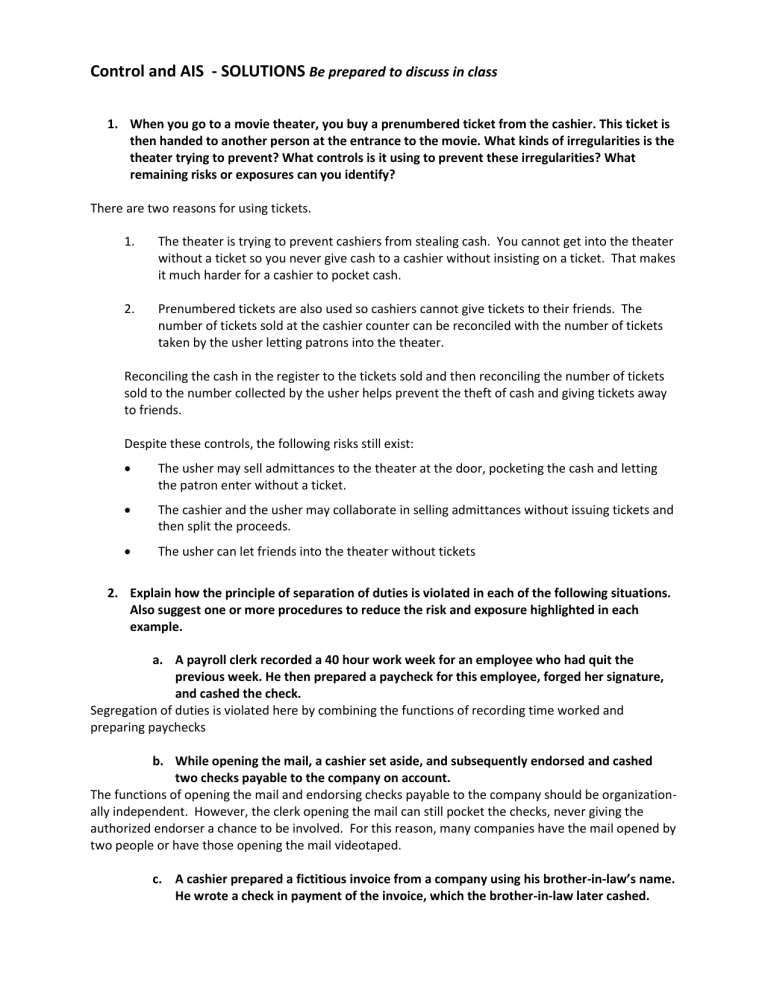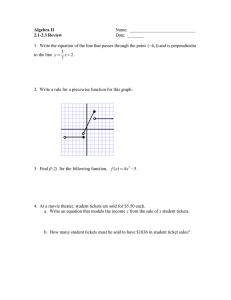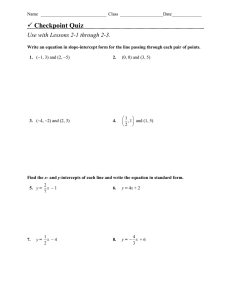
Control and AIS - SOLUTIONS Be prepared to discuss in class 1. When you go to a movie theater, you buy a prenumbered ticket from the cashier. This ticket is then handed to another person at the entrance to the movie. What kinds of irregularities is the theater trying to prevent? What controls is it using to prevent these irregularities? What remaining risks or exposures can you identify? There are two reasons for using tickets. 1. The theater is trying to prevent cashiers from stealing cash. You cannot get into the theater without a ticket so you never give cash to a cashier without insisting on a ticket. That makes it much harder for a cashier to pocket cash. 2. Prenumbered tickets are also used so cashiers cannot give tickets to their friends. The number of tickets sold at the cashier counter can be reconciled with the number of tickets taken by the usher letting patrons into the theater. Reconciling the cash in the register to the tickets sold and then reconciling the number of tickets sold to the number collected by the usher helps prevent the theft of cash and giving tickets away to friends. Despite these controls, the following risks still exist: The usher may sell admittances to the theater at the door, pocketing the cash and letting the patron enter without a ticket. The cashier and the usher may collaborate in selling admittances without issuing tickets and then split the proceeds. The usher can let friends into the theater without tickets 2. Explain how the principle of separation of duties is violated in each of the following situations. Also suggest one or more procedures to reduce the risk and exposure highlighted in each example. a. A payroll clerk recorded a 40 hour work week for an employee who had quit the previous week. He then prepared a paycheck for this employee, forged her signature, and cashed the check. Segregation of duties is violated here by combining the functions of recording time worked and preparing paychecks b. While opening the mail, a cashier set aside, and subsequently endorsed and cashed two checks payable to the company on account. The functions of opening the mail and endorsing checks payable to the company should be organizationally independent. However, the clerk opening the mail can still pocket the checks, never giving the authorized endorser a chance to be involved. For this reason, many companies have the mail opened by two people or have those opening the mail videotaped. c. A cashier prepared a fictitious invoice from a company using his brother-in-law’s name. He wrote a check in payment of the invoice, which the brother-in-law later cashed. The functions of authorizing payment of invoices and preparing checks for signature should be organizationally independent d. An employee of the finishing department walked off with several parts from the storeroom and recorded the items in the inventory ledger as having been issued to the assembly department. He then sold the parts on eBay. No employee should be permitted free access to the storeroom (a custodial function) and to the inventory ledger (a recording function). e. A cashier cashed a check from a customer in payment of an accounts receivable, pocketed the cash, and concealed the theft by properly posting the receipt to the customer’s account in the accounts receivable ledger. Custody of the checks and posting to the Accounts Receivable Ledger should be organizationally independent f. A purchasing agent received a 10% kickback of the invoice amount for all purchases made from a specific vendor. 3. During a recent review, ABC Corporation discovered that it has a serious internal control problem. It is estimated that the impact associated with the problem is $1 million and that the likelihood is presently 5%. Two internal control procedures have been proposed to deal with this problem. Procedure A would cost $25,000 and reduce likelihood to 2%: procedure B would cost $30,000 and reduce likelihood to 1%. If both procedures were implemented, likelihood would be reduced to one-tenth of 1%. a. What is the estimated expected loss associated with ABC Corporations’’ internal control problem before any new internal control procedures are implemented? b. Compute the revised estimate of expected loss if procedure A were implemented, if procedure B were implemented, and if both procedures were implemented. c. Compare the estimated costs and benefits of procedure A, procedure B, and both procedures combined. d. Considering only the estimates of costs and benefit, which procedure(s) should be implemented? What other factors might be relevant to this decision? e. a. Expected Loss = Risk X Exposure = 0.05 X $1,000,000 = $50,000 b. and c. Computation of revised expected loss and net benefits: Control Procedure Exposure Revised Expected Loss Reduction in Expected Loss Cost of Control(s) Net Benefit (Cost) Risk A 0.02 $1,000,000 $20,000 $30,000 $25,000 $ 5,000 B 0.01 $1,000,000 $10,000 $40,000 $30,000 $10,000 Both 0.001 $1,000,000 $ 1,000 $49,000 $55,000 $(6,000) Procedure B should be implemented because its net benefit is greater than A, or both A and B. Care must be taken with these discussions, however, because the numbers used are estimates. The net benefit figures are only as good as the estimates used to produce them. d. Considering only the estimated costs and benefits, control procedure B should be implemented. However, another important factor to consider is how critical the $1,000,000 loss would be to ABC Corporation. If ABC is a multi-billion dollar corporation, then they can afford to evaluate this matter strictly on the basis of estimated costs and benefits. However, if ABC is a small corporation, then a loss of this magnitude could threaten their continued existence, and it may be worthwhile to incur extra costs (as a form of insurance premium) to reduce the risk of loss to the smallest possible level. 4. A manufacturing firm’s controller created a fake subsidiary. He then ordered goods from the firm’s suppliers, told them to ship goods to a warehouse he rented, and approved the vendor invoices for payment when they arrived. The controller later sold the diverted inventory items, and the proceeds were deposited to the controller’s personal bank account. Auditors suspected something was wrong when they could not find any entries regarding this fake subsidiary office in the property, plant, and equipment ledgers or a title or lease for the office in the real-estate records of the firm. a. Describe the recommendations the internal auditors should make to prevent similar problems in the future. Implement a better segregation of duties. The company controller should not be able to order, ship, and authorize payment for inventory. Require all inventory purchases to be initiated by the purchasing department. Require all inventory payments to be supported by proper supporting documents such as receiving reports signed by authorized personnel. Require special authorization for shipments to locations not typically used.




